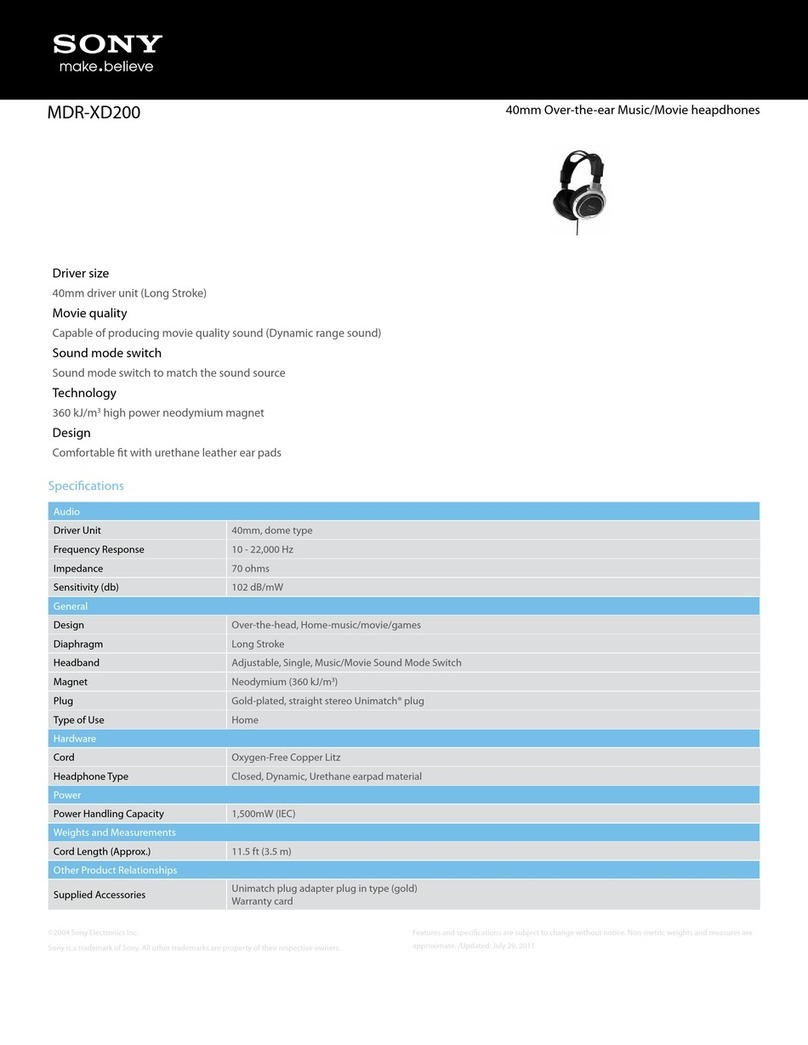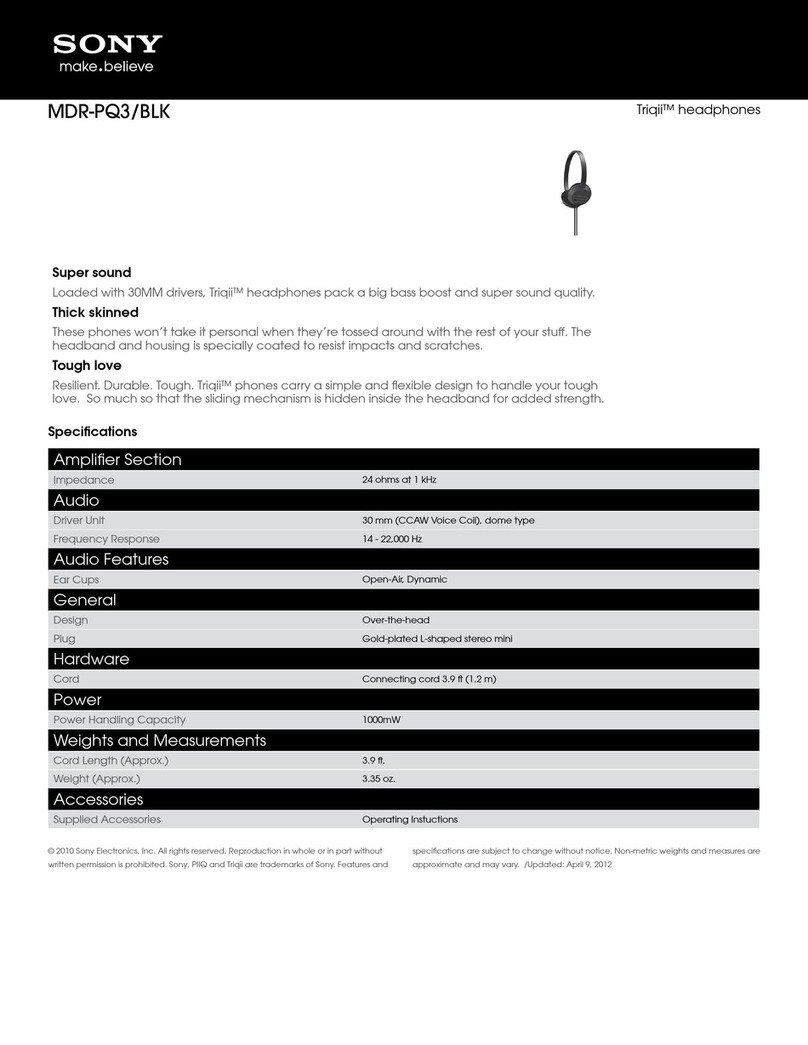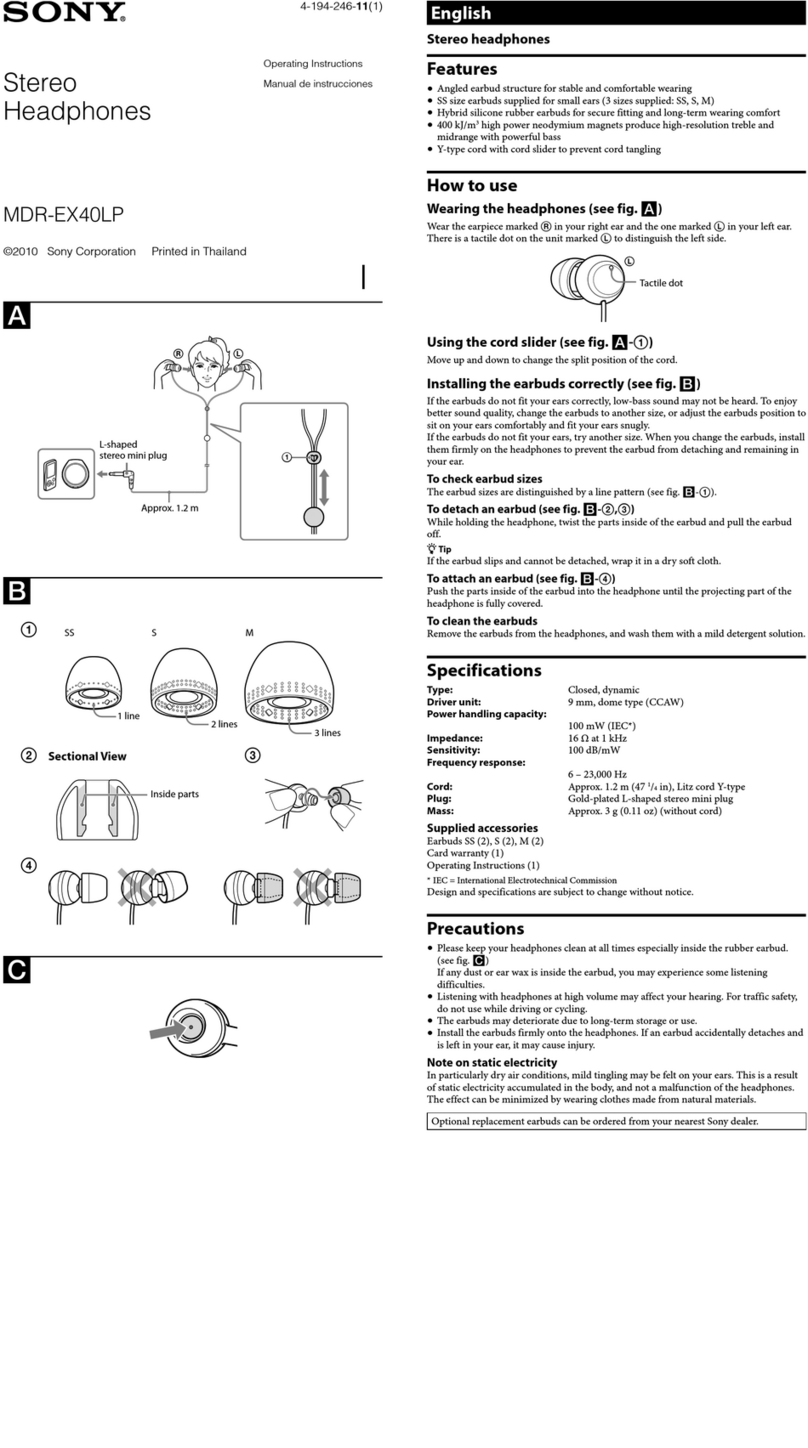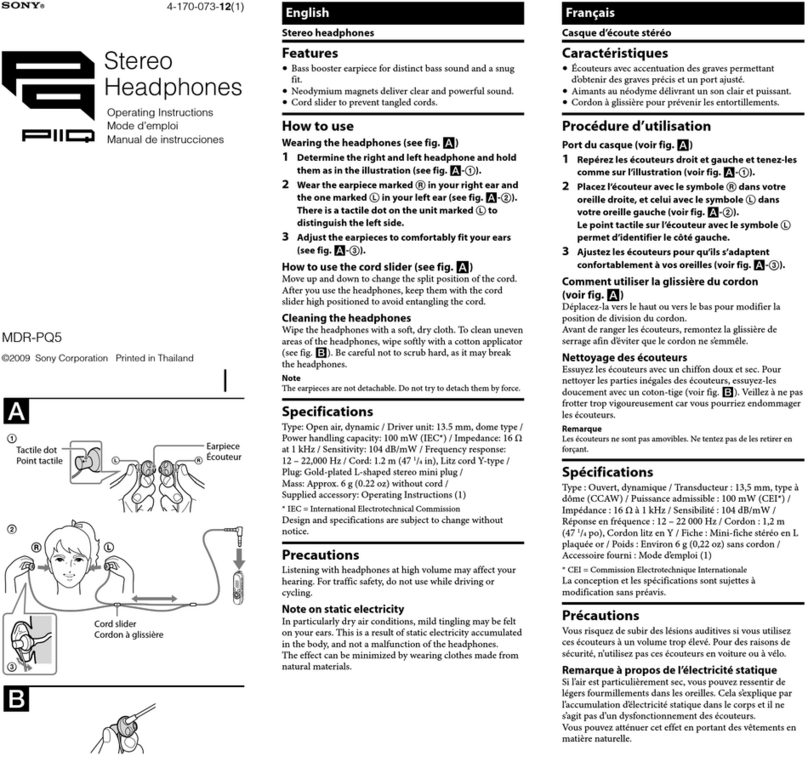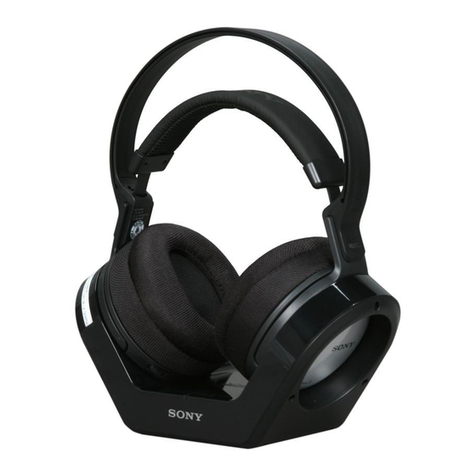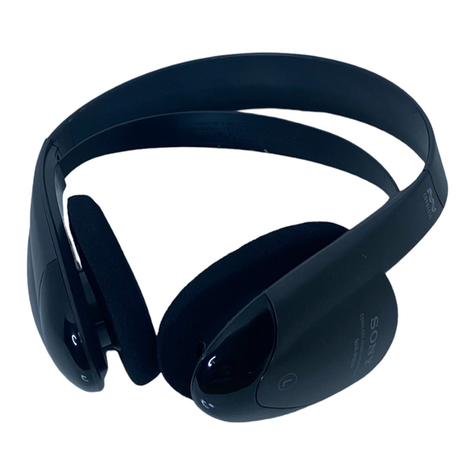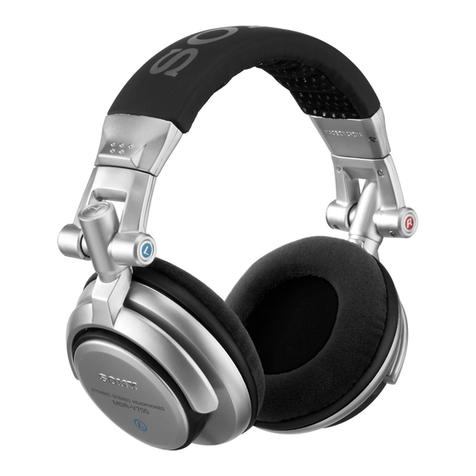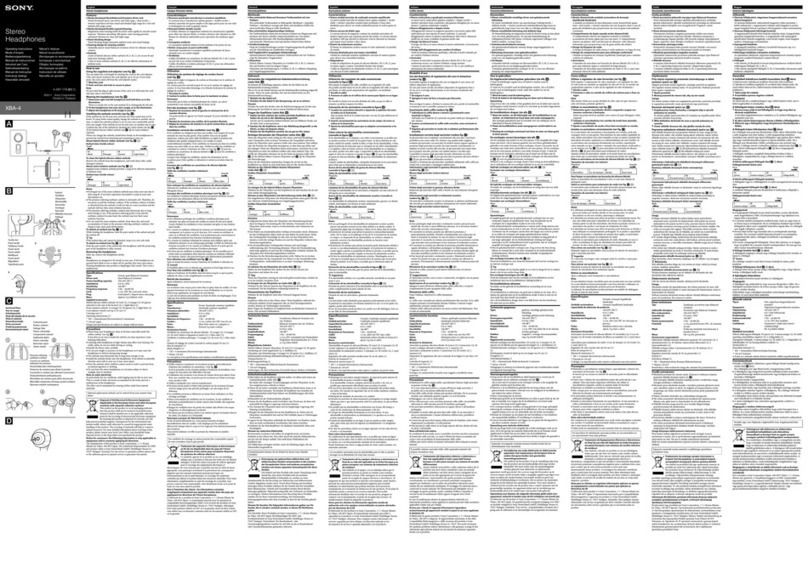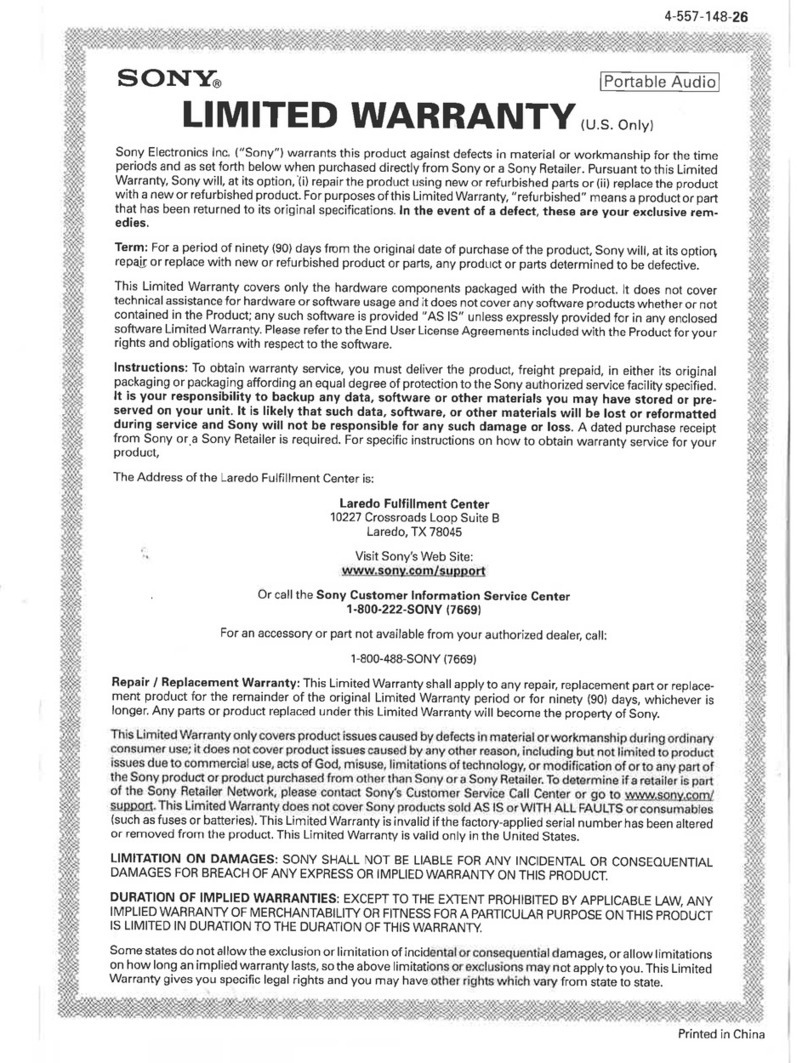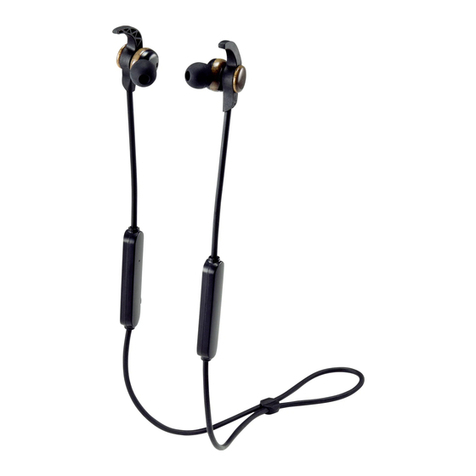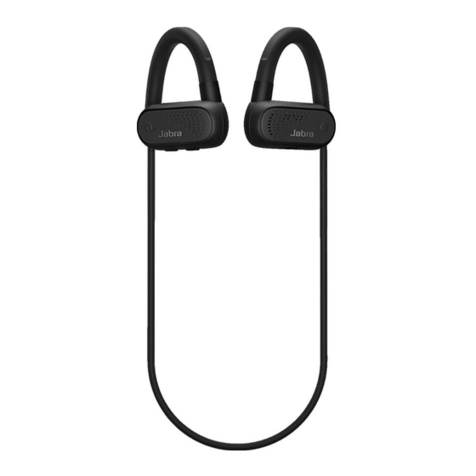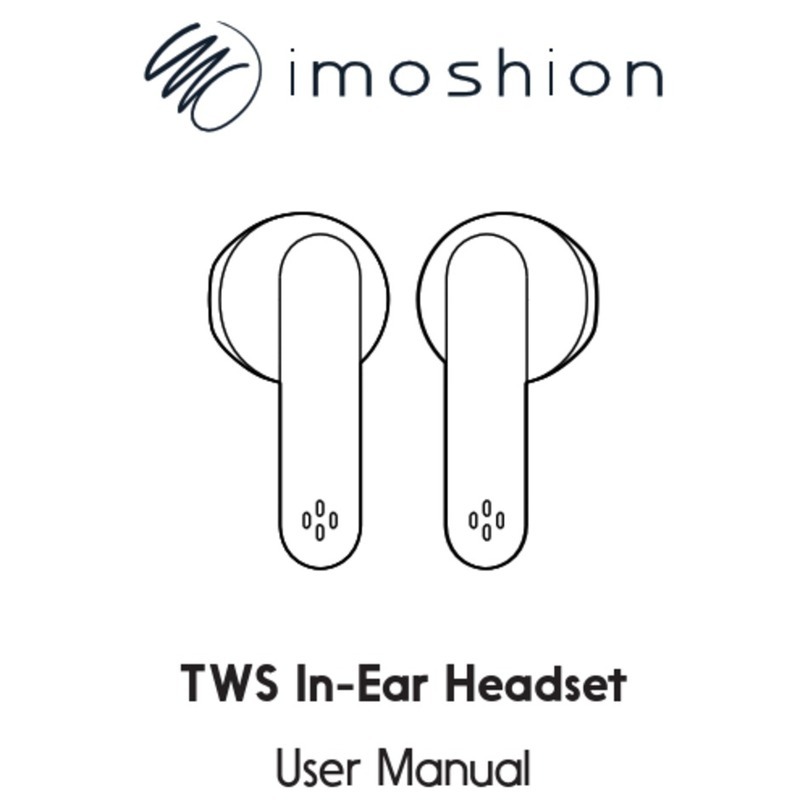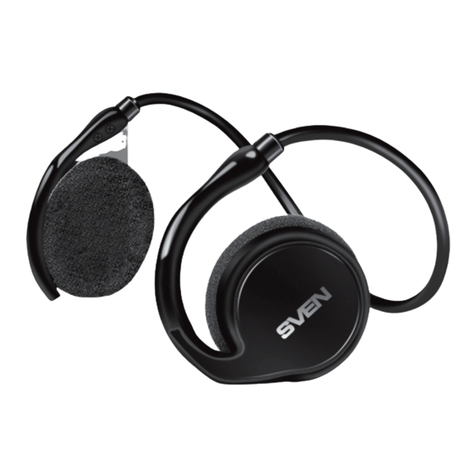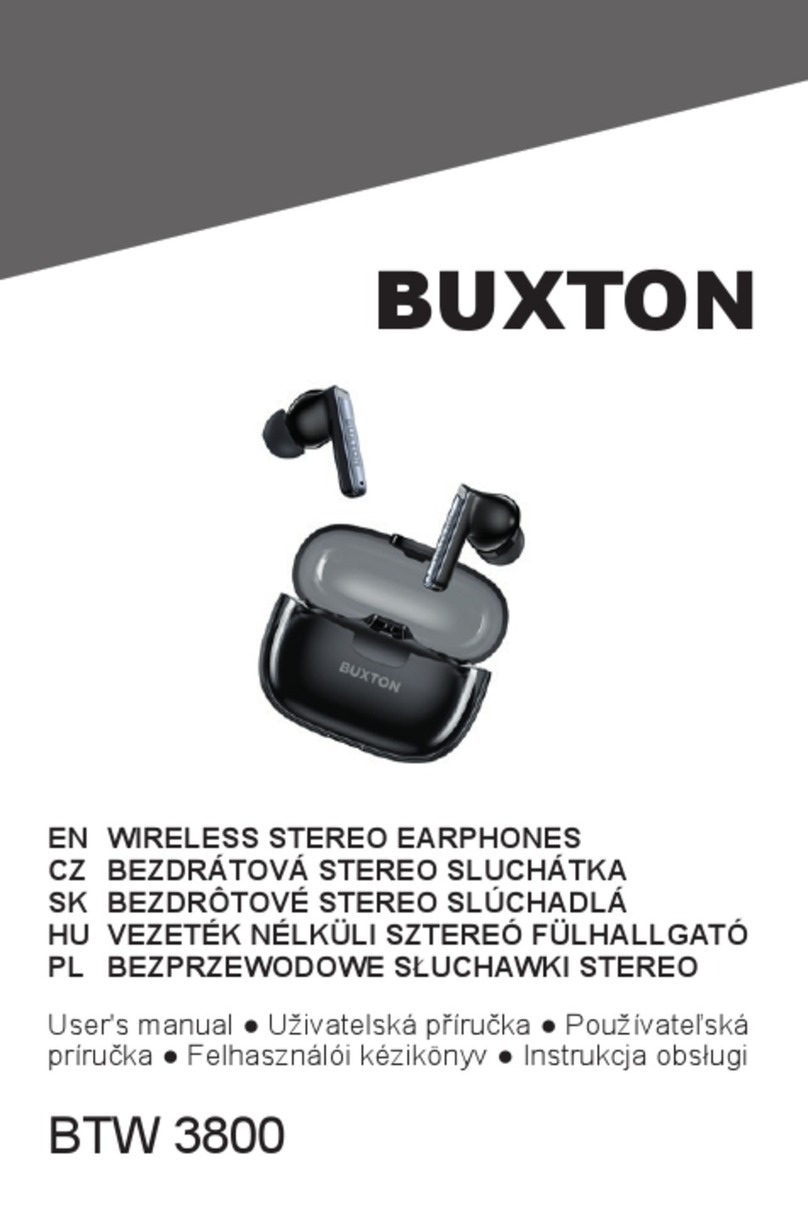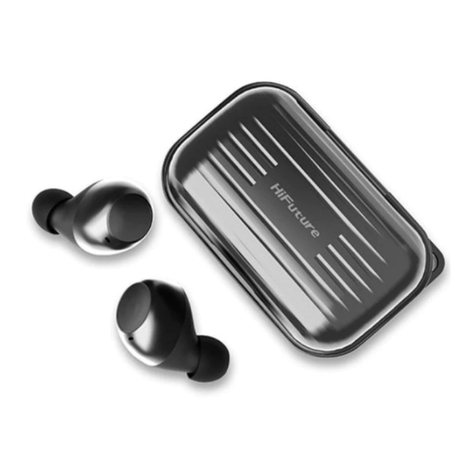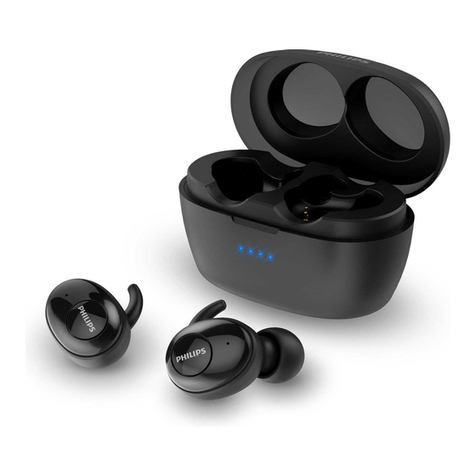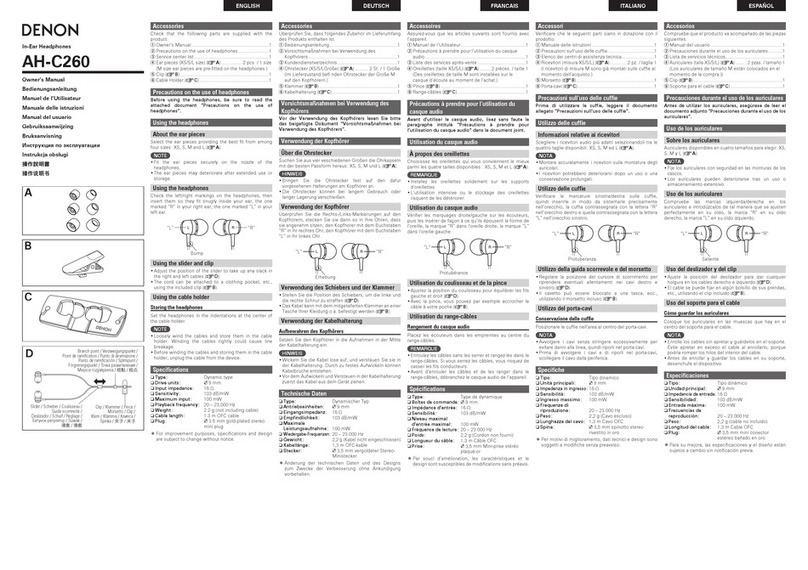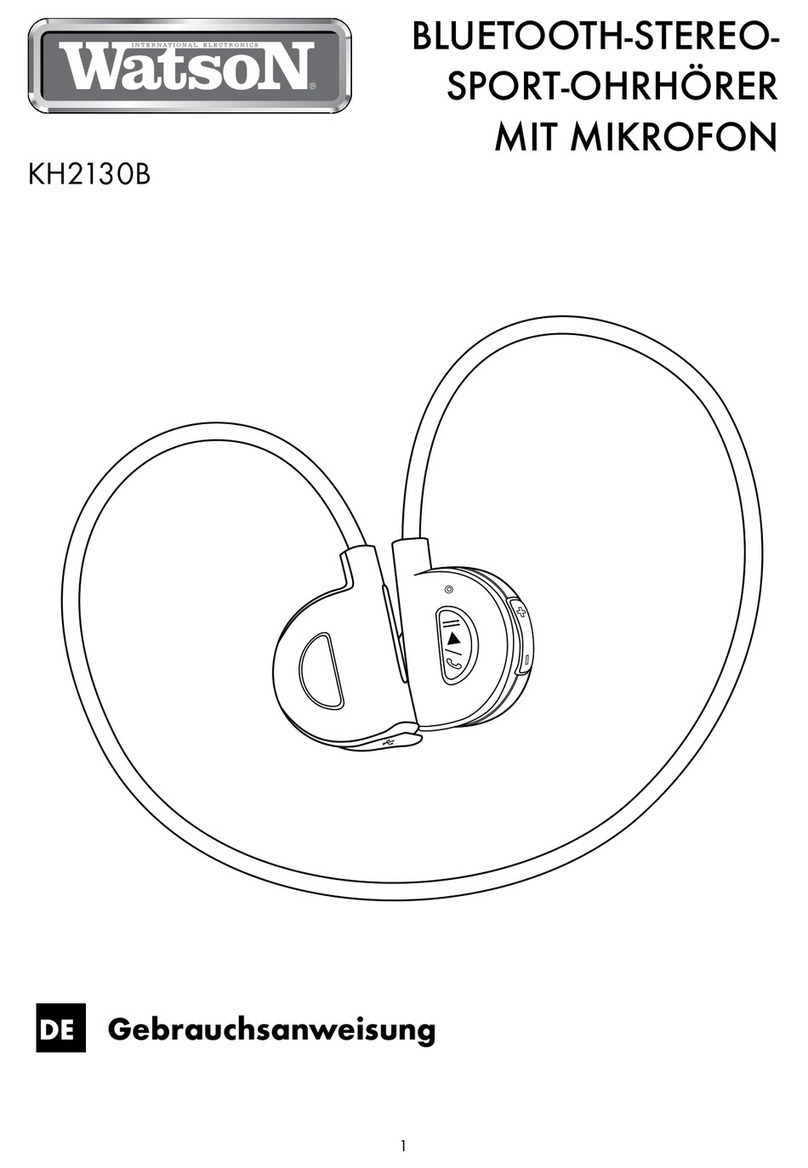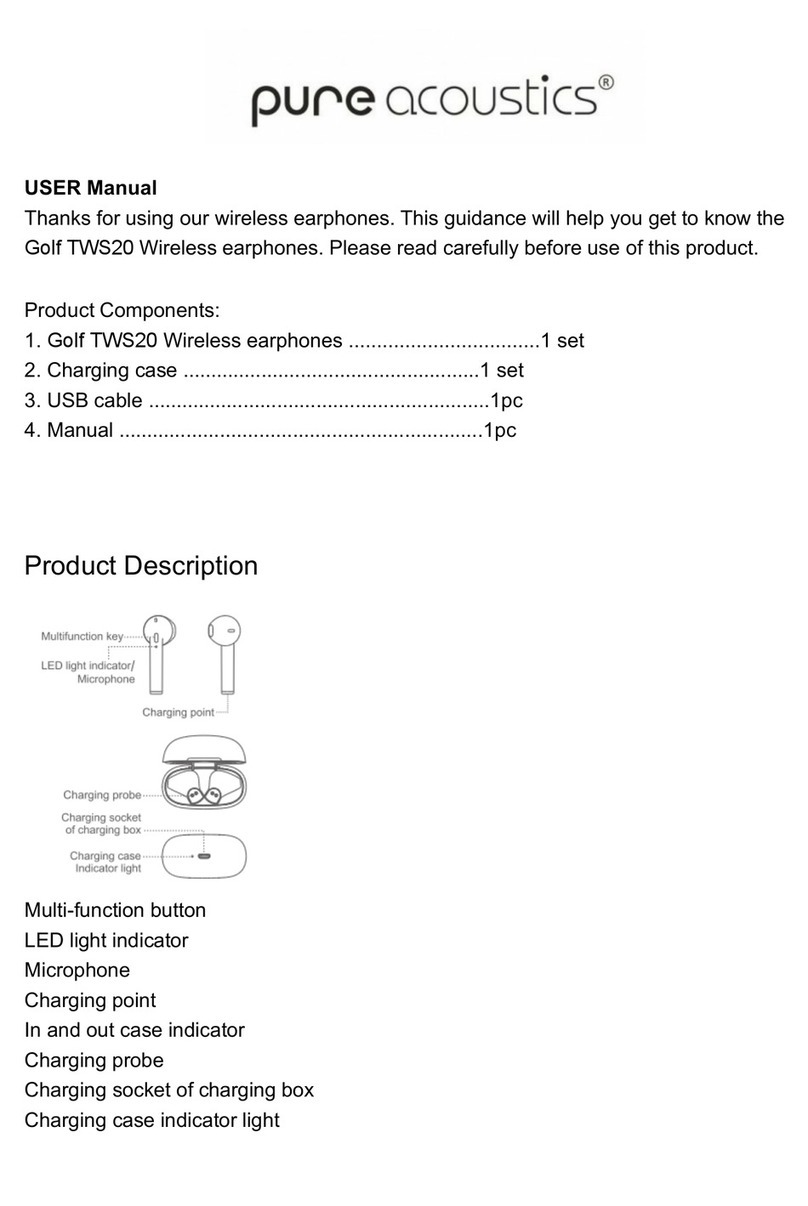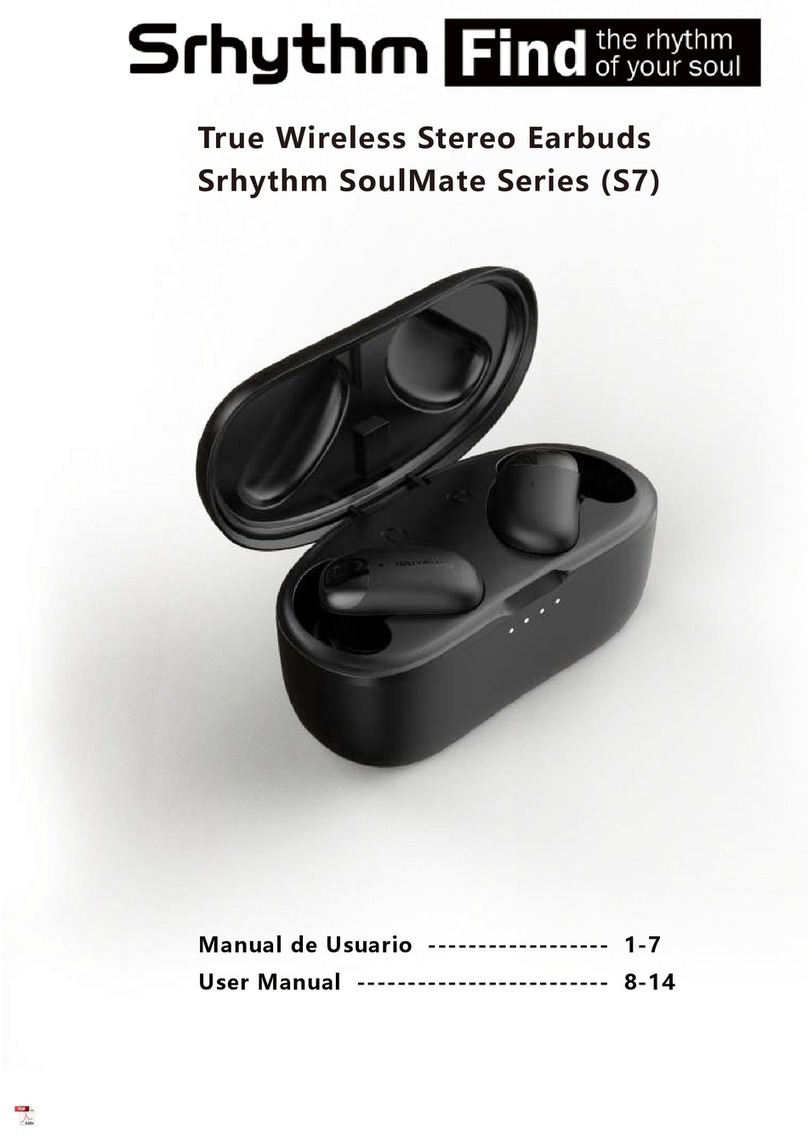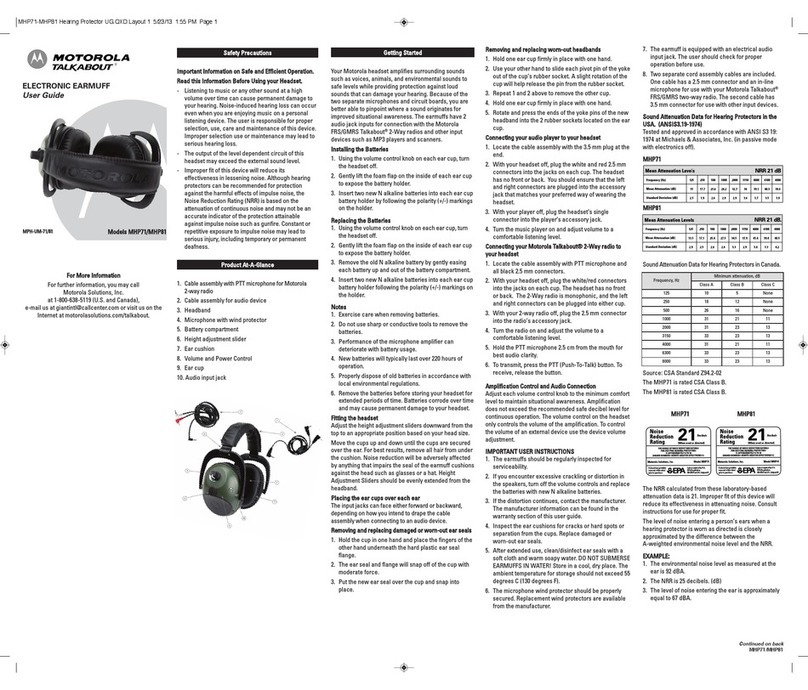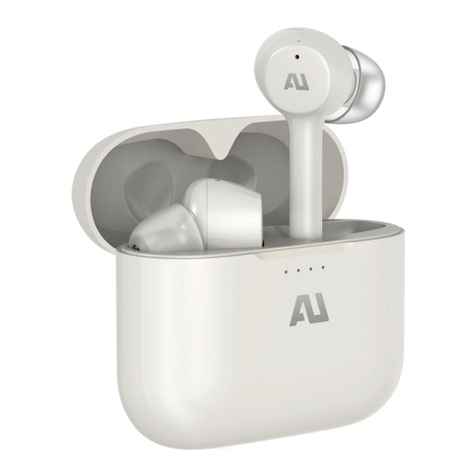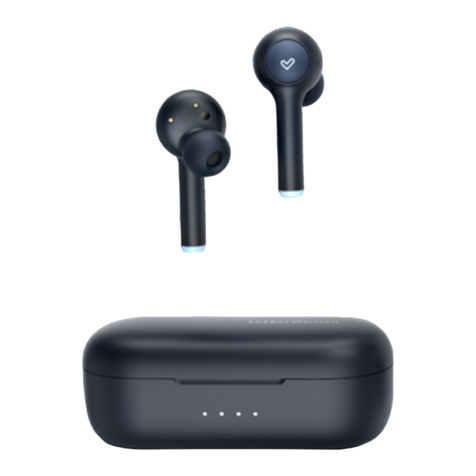
SONY MDR-RF4000K_U8 [US,ES] 4-170-882-52(1)
Notes on the transmitter with stand and
installation surface
The stand should not be placed on a surface that is cloth-
covered, textured, dirty or dusty.
Peel off the protection films (transparent) on the adhesive
sheets (4 corners) of the stand. The stand cannot be
installed with the protection films on the adhesive sheets.
When placing the transmitter, press it down softly to
steady the stand.
If the power of the adhesive sheets becomes
weak
Use a soft cloth slightly moistened to remove dust.A s oft
cloth with mild detergent solution mayb e used to remove
finger marks or grease. The power of the adhesive sheets will
be restored for repeate d use.
To change the installation place
Move the stand slowly with your fingerson the edge of the
stand. The adhesive sheets will not be detached with a sharp
move.
3Turn the left and right headphones so as to be flat.
4Insert the headphones in the transmitter so that
the headphones’ contactpoint meets the
transmitter’scontact pin, and make sure that the
CHG indicator lights up.
It takes approximate 16 hours to fully charge the battery
(the CHG indicator goes off when charging is complete).
When placing the headphones on the transmitter, be
sure to insert the left and right housings completely.
When the transmitter’s contact pin meets the
headphones’ contact point,t heCHG indicator lights up
in red.
If the CHG indicator is not lit
Be sure to close the battery compartment lid. The battery
charge function is not activated when the lid is not fully
closed.
Check that the left and right headphones are inserted in
the transmitter correctly.
The indicator will not light up if the headphones’ contact
point does not meet the transmitter’s contact pin. In this
case, remove the headphones and insert them in the
transmitter again so that the indicator lightsup.
Make sure that the supplied rechargeablenickel-metal
hydride battery is installed in the battery compartment.
You cannot charge any rechargeablebattery or dr y-cell
battery other than the supplied battery.
To rechargethe headphone batter y after use
Place the headphones on the transmitter after use. The CHG
indicator lights up, and then charging starts.
Since the built-in timer recognizes when charging is
complete, there is no need to remove the headphones from
the transmitter after charging has completed.
Notes
The transmitter automaticallyturns off while charging the battery.
This system is designed to charge only the supplied rechargeable
battery, type BP-HP550-11,for safety. Note that other types of
rechargeable battery cannot be chargedwith this system.
Youcannot charge any rechargeable battery or dry-cell battery
other than the supplied battery.
Do not attempt to use the supplied BP-HP550-11rechargeable
battery with other components. Itis for use with this system only.
Charge in an environmentaltemperature of between 0 °C and 40 °C
(between 32 °F and 104 °F). Otherwise, the battery may not be fully
charged.
Do not touch the contact pin of the transmitter. If a contact pin
becomes dirty, charging maynot be possible.
Charging may not be completed if the transmitter’s contact pin and
headphones’ contactp ointare dusty. Wipe them with a cotton bud,
etc.
Charging and usage time
Approx. charging time Approx. usage time*1
16 hours*27 hours*3
*1at 1 kHz, 1 mW + 1 mW output
*2hours required to fully chargean empty battery
*3Time may vary, depending ont hetemperature or conditions of
use.
This equipment has been tested and foundto comply with the limits
for a Class B digital device, pursuant to Part15 of the FCC Rules.
These limits are designed to provide reasonableprotection against
harmful interference in a residential installation.This equipment
generates, uses and can radiate radio frequency energy and, if not
installed and used in accordance with the instructions, may cause
harmful interference to radio communications.However, there is no
guarantee that interferencewill not occur in a partic ularinstallation.
If this equipment does cause harmful interferenceto radio or
television reception, which can be determined by turning the
equipment off and on,t he user is encouragedto tr y to correctthe
interference by one or moreof the following measures:
– Reorient or relocate the receiving antenna.
– Increase the separation between the equipment and receiver.
– C onnectt heequipment into an outlet on a circuit different from
that to which the receiver is connected.
– C onsultthe dealer or an experienced radio/TV technician for help.
You are cautioned that any changes or modificationsnot
expressly approvedin t his manual could void your authority
to operate this equipment.
For the customers in the USA
RECYCLING NICKEL METAL HYDRIDE
BATTERIES
Nickel Metal Hydride batteries are
recyclable.
You can help preserve our environment
by returning your used rechargeable
batteries to the collection and recycling
location nearest you.
For more information regarding recycling of
rechargeable batteries, call tollfree
1-800-822-8837, or visit http://www.rbrc.org/
Caution: Do not handle damaged or leaking Nickel
Metal Hydride batteries.
Welcome!
Thank you for purchasing the Sony MDR-RF4000K Wireless
Stereo Headphone System.B efore operating the unit, please
read this manual thoroughly and retain it forf uture
reference.
Some features are:
Wireless stereo headphone system formusic and movies
2.4 GHz digital transmission with high quality sound
Impressive sound reproduction with 40 mm driver unit
equipped high quality closed type headphones
2 way transmitter design for convenient setting
Easy battery charging system
Lightweight headphones for long time listening comfort
Real-time automatic tuning on headphones for best
reception of signal
Up to 100 feet reception range*
7 hours playback with supplied Ni-MH rechargeable
battery
Wireless Stereo
Headphone System
Operation
Listening to a programme
Before listening
To reducethe r iskof hearing damage, first lower the volume.
1Turn on the AVcomponent connected to the
transmitter.
If the transmitter is connected to the headphone jack,s et
the volume control of the audio sourcecomponent as
high possible but not so high that the audio signal
becomes distorted.
2Remove the headphones from the transmitter.
The transmitter’s POWER indicator lights up in green.
3Put on the headphones.
When you put on the headphones, the headphones’
power turns on automatically.
The POWER indicator on the right housing lights up. Be
sure to put the right housing on your right ear and
the left housing on your left ear. Wear the
headphones vertically on your head so that autop ower
on function is properly activated.
4Adjust the volume.
Volume control
Notes
When watching films, be careful not to raise the volume too
high in quiet scenes. Youmay hurt your ears when a loud scene
is played.
Youmay hear some noise when you disconnect the AC power
adaptor from the transmitterbefore removing the headphones.
RF signal transmission area
The approximate RF signal transmission area from the
transmitter is up to 100 ft (30 m).
The transmitter detects the optimum frequency
automatically when the headphones are removed from the
transmitter. The sound may be interrupted if the
headphones are out of RF signal transmissionarea or
reception conditions deteriorate. Inthis cas e,move closer to
the transmitter.
Notes
Because this system transmits signals at 2.4 GHz, sound may be
interrupted if interference occurs. This is due to radio frequency
characteristics, and is not a malfunction.
Any noise you hear through the headphones may vary depending
on the transmitter position and roomconditions. It is
recommended that you place the transmitterin a location that
produces the clearest sound.
Sound may be interrupted if the transmitter is used withother
wireless apparatususing 2.4 GHz frequency, or a microwave oven.
If an audio signal is not input for 10 minutes
RF signal transmission from the transmitter automatically
stops when an audio signal is not input for10 minutes.
When the transmitter stops, the transmitter’s POWER
indicator blinks in green for 30 seconds and then turns off.
The RF signals are automatically transmitted when an audio
signal is input again. RF signal transmission may stopw hen
an extremely low sound is input forabout 10 minutes. If this
happens, raise the volume of the connected AV component
and lower the volume of the headphones. If signal noiseis
output from a component connected to the PHONES IN
jacks, RF signal transmission may not stop.
The headphones automatically turn off when
they are removed
— Auto Power On/Off function
Do not pull up the self-adjusting band when not in use, as
this will consume the battery power.
Self-adjusting
band
©2010 Sony Corporation Printed in China
MDR-RF4000K
4-170-882-52(1) Easy connection with TV/DVD/audio equipment with
supplied audio cable
Automatic On/Off function on headphonesto preserve
battery life
Free adjustable headband for precise andcomfortable fit
Volumecontrol function on the headphones
* Transmissiondistance varies depending on conditions of use.
Preparation
Checking the components and
accessories
Before setting up the system, check that all of the
components are included.
Transmitter TMR-RF4000 (1)
Wireless stereo headphones MDR-RF4000 (1)
AC power adaptor (1)
Rechargeable nickel-metal hydride battery BP-HP550-11 (1)
Connecting cable (stereo mini plug pin plug × 2),
1 m (39 3/8in) (1)
Unimatch plug adaptor (stereo mini jack stereo phone
plug) (1)
Stand (1)
Inserting the supplied
rechargeable nickel-metal
hydride battery
The supplied rechargeable nickel-metal hydride battery is
not charged from the first time you use it. Be sure to charge
it before use.
To charge the headphones, place them on the transmitter.
1Press the PUSH button of the left housing to open
the battery compartment lid.
The battery compartment lid comes off.
PUSH button
English
WARNING
Toreduce the risk of fire or electric shock, do not
expose this apparatus to rain or moisture.
To avoid electrical shock, do not open the cabinet. Refer
servicing to qualified personnel only.
For the customers in the USA
Owner’s Record
The model number is located at the bottom of the
transmitter and the left inner side of the headband.
The serial number is located at the bottom of the transmitter
and the inner side of the battery compartment.
Record these numbers in the spaces provided below. Refer to
them whenever you call upon your Sony dealer regarding
this product.
Model No. MDR-RF4000K
Transmitter TMR-RF4000
Headphones MDR-RF4000
Serial No.
Transmitter
Headphones
NOTE
The Transmitterand Wireless stereo headphones must not be co-
located or operated in conjunction withany other antenna or
transmitter.
This Transmittercomplies with FCC radiation exposure limits set
forth for uncontrolled equipmentand meets the FCC radio frequency
(RF) Exposure Guidelines in Supplement C to OET65.This
Transmitterhas very low levels of RF energy that it deemed to comply
without maximum permissive exposure evaluation(MPE). This
Transmitteris desirable that it should be installed and operated with
at least 20 cm and more between the radiator andp erson’s body
(excluding extremities: hands, wrists, feet and ankles).
The Wireless stereo headphonescomply with FCC radiation exposure
limits set forth for uncontrolled equipmentand meets the FCC radio
frequency (RF) Exposure Guidelines in Supplement C to OET65.The
Wireless stereo headphoneshave very low levels of RF energy that it is
deemed to comply withouttesting of specific absorption ratio (SAR).
NOTICE FOR THE CUSTOMERSIN THE U.S.A.
NOTE
This device complies with Part 15 of the FCC Rules.
Operation is subject to the following two conditions: (1)this
device may not cause harmful interference, and (2)this
device must accept any interference received,including
interference that may cause undesired operation.
Checking the remaining
battery power
Pull up the self-adjusting band and check the POWER
indicator located on the right housing. The battery is still
serviceable when the indicator lights in red.
Charge the rechargeable battery or i nstall new dry-cell
batteries if the POWER indicator light dims, flashes, or the
sound becomes distorted or noisy.
Note
The rechargeable nickel-metal hydridebattery should be replaced
with a new one when it lasts only half the expected time, after a full
charge has been performed. The rechargeable battery, type BP-
HP550-11, is not commercially available.You can order the battery
from the store where you purchased this system, or atyour nearest
Sony dealer.
Using the headphones with
alkaline batteries (sold
separately)
Commercially available (size AAA) alkaline batteries can
also be used to power the headphones. Install the batteries
in the same manner as described in “Inserting the supplied
rechargeable nickel-metal hydride battery.”
When dry-cell batteries are installed, the battery charge
function is not activated.
Battery life
Battery Approx. hours*1
Sony alkaline batteries
LR03/AM-4(N)
10 hours*2
*1at 1 kHz, 1 mW + 1 mW output
*2Time may vary, depending onthe temperature or conditions of
use.
Notes on Batteries
Do not charge a dry-cell battery.
Do not carry a dry-cell battery together with coins or other metallic
objects. Heat can be generated by the battery if itsp ositiveand
negative terminals are accidentally shorted.
If you are not goingto use t he unitfor a long time, remove the
batteries to avoid damagefrom battery leakage or corrosion.
Connection
Setting up the transmitter
1Connect the transmitter to an AV component.
Select one of the hookups below depending on the jack
type:
To connect toa he adphones jack
Transmitter
Left channel
(white)
Right channel
(red)
To PHONES IN
jacks
Connecting cord
(supplied)
Unimatch plug
adaptor (supplied)
To headphones
jack (Stereo
phone jack)
To headphones jack
(Stereo mini jack)
WALKMAN®*,
TV, etc.
To connect toLINE OUT or REC OUT jack
Transmitter
To LINE IN jack
Right channel (red)
Connecting cord
(supplied)
Stereo system,
VCR, etc.
To LINE OUT or
REC OUT jacks
Left channel (white)
* “WALKMAN”and “WALKMAN” logo areregistered trademarks
of Sony Corporation.
2Insert the supplied rechargeable nickel-metal
hydride battery into the battery compartment,
matching terminal on the battery to the mark
in the compartment.
Do not attempt to chargeany other kind of battery with
this unit.
Note
The battery compartment has a tab on the side which holds the
rechargeable battery in place. Insert the terminal first when
installing the rechargeable battery.
3Close the battery compartment lid.
Insert the tab in the hole at the top left.
Close the lid until it clicks.
Charging
1Connect the supplied AC power adaptor to the
transmitter.
Transmitter
AC power adaptor
(supplied)
To an ACoutlet
To DC IN
5.2 V jack
Notes
Be sure to use the supplied AC power adaptor. Using AC
adaptors with differentplug polarity or other characteristics
can cause product failure.
Unified polarity plug
Be sure to always use the supplied AC power adaptor. Even AC
power adaptors havingthe s amevoltage and plug polarity can
damage this product due to the current capacityor other
factors.
Connect the AC power adaptor toan easily accessible AC
outlet. Should you notice an abnormalityin the AC power
adaptor,disconnect it from the AC outlet immediately.
2Put the stand to the transmitter.
You can place the transmitter horizontally or vertically,
using the stand.
Replacing the earpads
The earpads are replaceable. If the earpads become dirty or
worn out, replace them as illustrated below. The earpads are
not commercially available. You can order replacements
from the store where you purchased this system, or atyour
nearest Sony dealer.
1Remove the old earpad by pulling it off.
2Place the new earpad around the housing.
Additional information
Troubleshooting
If you run into any problemsusing this he adphone system,
use the following checklist. Should any problem persist,
consult your nearest Sony dealer.
No sound
Check the connection between the transmitter andthe AV
component.
Check that the connected AVcomponent's optical digital output
is set to “ON”when selecting digital input.
Turnon the AV component connected to the transmitter, and
start the playback.
If you connect the transmitterto an AV component using the
headphone jack, raise the volume level on the connected AV
component.
Make sure you are wearing the headphonescorrectly.
Raise the headphone volume.
The headphones’ POWERindicator goes off.
Charge the rechargeable battery if itis weak, or replace alkaline
batteries with new ones. If the POWER indicatoris still off
after charging the battery,take the headphones to a Sony
dealer.
Distorted or intermittent sound
(sometimes with noise)
Charge the rechargeable battery if itis weak, or replace alkaline
batteries with new ones. If the POWER indicatoris still off after
charging the battery,take the headphones to a Sony dealer.
Check if there is any wireless apparatus using 2.4 GHz frequency,
or a microwave ovenin the vicinity.
Change the position of the transmitter.
If you connect the transmitterto an AV component using the
headphone jack, lower the volume levelon the connected AV
component.
Low sound
If you connect the transmitterto an AV component using the
headphone jack, raise the volume level on the connected AV
component.
Raise the headphone volume.
Loud background noise
Check if there is any wireless apparatus using 2.4 GHz frequency,
or a microwave ovenin the vicinity.
If you connect the transmitterto an AV component using the
headphone jack, raise the volume level on the connected AV
component.
Charge the rechargeable battery if itis weak, or replace alkaline
batteries with new ones. If the POWER indicatoris still off after
charging the battery,take the headphones to a Sony dealer.
The sound cuts off.
The transmitter stops transmitting if no signal is inputfor 10
minutes.
If you connect the transmitter toan AV component using the
headphone jack, raise the volume level on the connected AV
component.
The battery cannot be charged.
Check if the CHG indicator turns on. Ifnot, put the headphones
on the transmitter correctly so thatt heCHG indicator turns on.
Dry batteries are installed.
Insert the supplied rechargeable nickel-metalhydride battery.
Rechargeable batteries other than the suppliedare installed.
Insert the supplied rechargeable nickel-metalhydride battery.
The transmitter’s contact pin and headphones’ contact pointare
dusty.
Wipe them with a cottonbud, etc.
A repeated beep sounds.
The headphones cannot receive the signal fromt hetransmitter.
Move within the RF signal transmissionarea.
Check the connection of the transmitter, AC power adaptor,
and AC outlet.
Check if there is any wireless apparatus using 2.4 GHz
frequency, or a microwave oven around the transmitter and
headphones.
Change the position of the transmitter.
There is no audio signal input forabout 10 minutes and RF
signals are not transmitted.
Input the audio signal to the transmitter.
The unit does not operate properly.
Reset the system.
Push a small pin, etc., into the hole of the transmitteruntil you
feel a click.
The POWER indicator on top starts blinkingin green.
Once the POWER indicator starts blinking, pull up and hold
the self-adjusting band to turn on the headphones, andpush a
small pin, etc., into the hole of the right headphone until you
feel a click.
The POWER indicator of the transmitterstops blinking and
stays lit in green.
Precautions
On safety
Do not drop, hit, or otherwise expose the headphones to
strong shock of any kind. This could damage the product.
Do not disassemble or attempt to open any parts of the
system.
On power sources and placement
If you are not going to use the system fora long time,
unplug the AC power adaptor from the AC outlet. When
removing the plug, grip the AC power adaptor.
Do not pull on the cord.
Do not place the system in any of the following locations.
– Location exposed to direct sunlight, near a heater,or
other extremely high-temperature location
– Dusty location
– On an unsteady or inclined surface
– Location exposed to large amounts of vibration
– Bathroom or other high-humidity locations
On headphones
Act considerately
When the volume is too high, the sound leaks outside the
headphones. Be careful not to raise the volume so high that
it bothers people around you.
There is a tendency to raise the volume when using in noisy
places. However,for reasons of safety, it is advised to keep
the volume at a level whereby you can still hear sounds
around you.
On cleaning
Use a soft cloth slightly moistened with mild detergent
solution. Do not use solvents such as thinner,b enzene or
alcohol as these may damage the surface.
When the product breaks
When the product breaks, or if a foreign object getsinside
the unit, immediately turn off the power and consultyour
nearest Sony dealer.
When taking the system to a Sony dealer, be sure tot ake
both the headphones and transmitter.
Specifications
Wireless stereo transmitter (TMR-RF4000)
Modulation System
GFSK
Carrier wave frequency
2.404 GHz - 2.476 GHz
Transmission distance
Approx. 100 ft (30 m) of longest
Frequency response
10 Hz - 22,000 Hz
Distortion rate
1% or less (1 kHz)
Audio inputs
Phono jacks (left/right)
Stereo mini jack
Power requirements
DC 5.2 V (from the supplied AC power adaptor)
Dimensions
Approx. 246 mm × 62 mm × 129 mm
(9 3/4in × 2 1/2in × 5 1/8in) (w/h/d)
Mass Approx. 430 g (15.2 oz)
Wireless stereo headphones (MDR-RF4000)
Playback frequency range
12 Hz – 22,000 Hz
Power requirements
Rechargeable nickel-metal hydride battery
(supplied) or commercially available(size AAA)
alkaline batteries
Mass Approx. 300 g (10.6 oz) (including the supplied
rechargeable nickel-metal hydride battery)
Supplied accessories
AC power adaptor (5.2 V) (1)
Rechargeable nickel-metal hydride battery
BP-HP550-11 (550 mAh) (1)
Connecting cable (stereo mini plug pin plug
× 2), 1 m (39 3/8 in) (1)
Unimatch plug adaptor (stereo mini jack
stereo phone plug) (1)
Stand (1)
Card warranty (1)
Operating Instructions (this manual) (1)
Recommended accessories
Optical digital connecting cable POC-15AB
(1.5 m, 59 1/8in) (mini-plug rectangular plug)
Design and specifications are subject to change without
notice.
Operating Instructions
Manual de instrucciones
